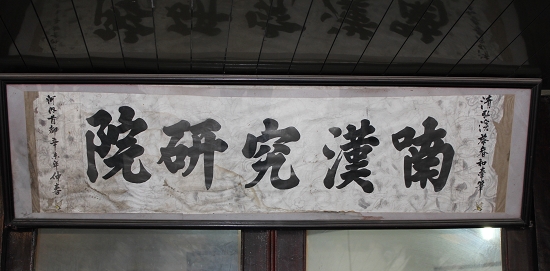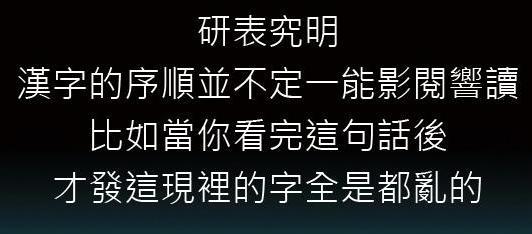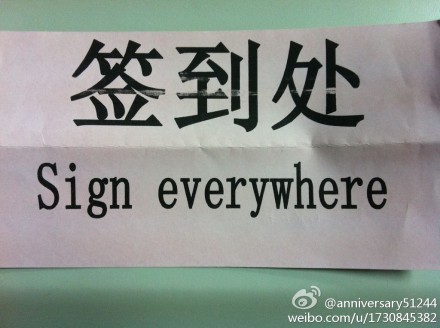Archive for Writing systems
July 16, 2013 @ 12:42 am· Filed by Victor Mair under Writing systems
On May 28, 2013, I made the following post: "Vietnamese in Chinese and Nom characters". The discussion that followed, as usual at Language Log, was lively and informative, and raised a lot of very interesting issues concerning the history and nature of Nom and its relationship to Chinese characters and Chinese languages.
John Balaban had wanted to participate in that discussion, but was delayed by heart surgery (he's all right now), and has taken the first opportunity to send in these remarks, which help us to understand why many people, including some of my own students and colleagues, still care passionately about this unique writing system.
Read the rest of this entry »
Permalink
July 10, 2013 @ 9:47 pm· Filed by Victor Mair under Borrowing, Words words words, Writing systems
In "Why so little Chinese in English?", Robert Lane Greene ponders the paucity of recent Chinese loanwords in English, and there is a further discussion on Language Hat. English loves to borrow far and wide, yet it is strange how few words of Chinese origin there are in English. This is particularly odd for recent times, when there has been so much contact between Chinese and English speakers, and there have even been campaigns on the part of Chinese officials, journalists, and netizens to promote particular expressions for adoption into English.
Read the rest of this entry »
Permalink
July 7, 2013 @ 8:37 am· Filed by Victor Mair under Variation, Writing systems
At the conclusion of "Mystery characters and variant characters", I promised that I would introduce Language Log readers to some truly weird characters. Herewith, I fulfill that pledge by presenting the following five photographs forwarded to me by Don Clarke. They were taken by a friend of his in Shēnkēng 深坑 ("Deep Pit"), Taiwan.
Read the rest of this entry »
Permalink
June 11, 2013 @ 6:05 pm· Filed by Victor Mair under Spelling, Writing systems
The following photograph was taken at a Springfield, Massachusetts restaurant named “Nippon Grill and Seafood Buffet”:

Read the rest of this entry »
Permalink
June 4, 2013 @ 8:39 pm· Filed by Victor Mair under Tones, Words words words, Writing systems
Practically everybody has heard of the fabled Grass Mud Horse (cǎonímǎ 草泥马), which is a pun for "f*ck your mother" (cào nǐ mā 肏你妈). China Digital Times, which pioneered research on "sensitive words", including "Grass Mud Horse", has just introduced a new feature, which should prove to be a useful resource for China scholars and journalists: "Two Years of Sensitive Words: Grass-Mud Horse List".
You will observe that not one of the tones of cǎonímǎ 草泥马 ("Grass Mud Horse") matches the corresponding tone in the original cào nǐ mā 肏你妈 ("f*ck your mother"), yet no one has the slightest difficulty in comprehending that the former is meant as a pun for the latter.
Read the rest of this entry »
Permalink
May 28, 2013 @ 10:14 pm· Filed by Victor Mair under Writing systems
The Dōngfāng zǎobào 东方早报 (Oriental Morning Post / dfdaily) (May 26, 2013) carried an article entitled "Dāng rénmen dōu xiě Hànyǔ shí" 当人们都写汉语时 (When everyone writes Chinese) that begins with the following photograph:

Read the rest of this entry »
Permalink
May 16, 2013 @ 8:58 am· Filed by Victor Mair under Dialects, Writing systems
Just yesterday, in "The enigmatic language of the new Windows 8 ads", we saw how delicate and uncertain is the comprehension of forms of Chinese that one is not intimately familiar with. A significant part of the problem is the result of a psychological barrier to understanding that comes from unfamiliarity with the context and content of what is being said. Thus, even though there was a considerable amount of Mandarin spoken in the videos of my post about the Windows 8 ads, of the scores of native speakers whom I consulted, no one could pick it out from the stream of sounds they were hearing.
The most important obstacle to intelligibility, of course, is the sheer difference (in grammar, syntax, phonology, vocabulary, etc.) among the topolectal varieties of Chinese. In this post, to show how dissimilar Modern Standard Mandarin (MSM) is from one of the most important Sinitic topolects, we shall look closely at a text composed in rather colloquial Shanghainese.
Read the rest of this entry »
Permalink
May 12, 2013 @ 8:47 am· Filed by Victor Mair under Quizzes, Writing systems
In "Unknown Language #7", I described the case of a woman in a refugee center in Kathmandu, Nepal who spoke in an unidentifiable tongue and who wrote in an odd mixture of languages and scripts. The post generated a large number of comments (173 at last count), with a tremendous amount of helpful information and analysis being shared by Language Log readers.
Now I have just heard from Son Ha Dinh, who first brought this case to my attention, that — with the help of Language Log readers and the diligent efforts of his colleagues — the identity of the woman has been determined.
Read the rest of this entry »
Permalink
April 20, 2013 @ 12:56 pm· Filed by Victor Mair under Alphabets, Borrowing, Dialects, Writing systems
The Dungan people are a group of Sinitic speakers whose Muslim ancestors fled to Central Asia (mainly in parts of what are now Kyrgyzstan and Kazakhstan) over a century ago when the Qing (Manchu) government suppressed their revolt (1862-1877), one of many Muslim uprisings in the course of Chinese history since Islam arrived in East Asia during the Middle Ages.
When they came to Central Asia, the Dungans were mostly illiterate peasants from northwest China who spoke a series of topolects from Shaanxi, Gansu, and other areas. From 1927 to 1928, they wrote their language with the Arabic alphabet, and from 1928-1932 they used the Latin alphabet. In 1952-53, the Soviet government created for the Dungans a writing system based on the Cyrillic alphabet, which they continue to use till today.
Read the rest of this entry »
Permalink
April 19, 2013 @ 11:49 am· Filed by Victor Mair under Language and gender, Transcription, Writing systems
I missed this article in the Chinese edition of China Daily when it first appeared on June 20, 2012, but it raises an issue that is sufficiently important to warrant addressing now that William Steed has kindly called my attention to it:
"Qián Jīnfán: 84 suì hòu kuà xìngbié 'rénshēng de cànlàn qī cáigāng kāishǐ'” 钱今凡:84岁后跨性别 “人生的灿烂期才刚开始” ("Qian Jinfan: 'the most glorious period of a person's life only begins' after age 84 when one transcends gender")
Read the rest of this entry »
Permalink
April 13, 2013 @ 6:48 am· Filed by Victor Mair under Language play, Silliness, Writing systems
I knew it wouldn't be long before someone came up with a Chinese equivalent to alphabetical typoglycemia:

Read the rest of this entry »
Permalink
March 17, 2013 @ 10:28 am· Filed by Victor Mair under Language and culture, Names, Writing systems
If you like Japanese food, you are undoubtedly familiar with "teppanyaki", so you probably wouldn't be surprised to see a sign like this in your neighborhood, as did Jim Breen near his home in Melbourne:

Read the rest of this entry »
Permalink
March 11, 2013 @ 8:44 pm· Filed by Victor Mair under Lost in translation, Parsing, Writing systems
The following sign was posted on Weibo (China's Twitter clone):

Read the rest of this entry »
Permalink




